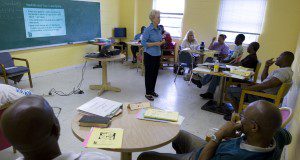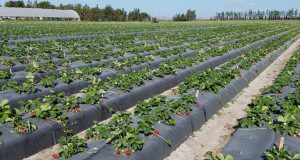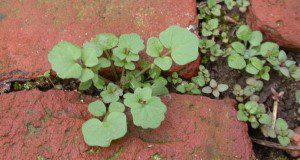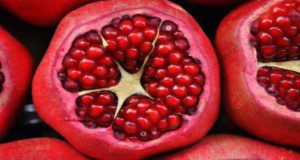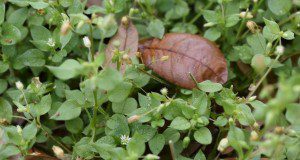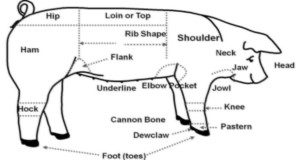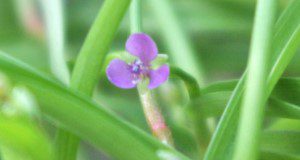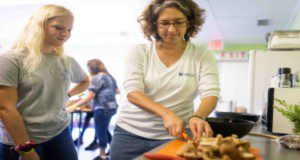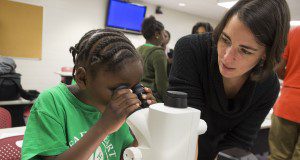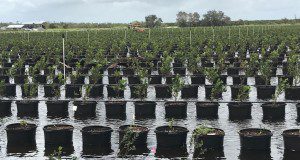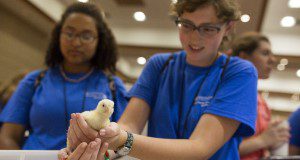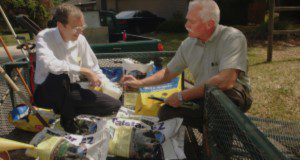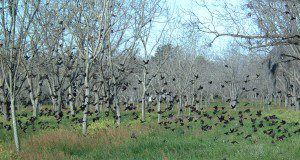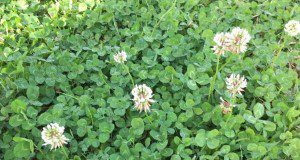A successful needs assessment is contingent on participation from the right people, so understanding potential motivations, barriers, and objections specific to your participants is critical. This new 5-page publication, the fourth in the Conducting the Needs Assessment series, provides Extension educators and other service providers with an overview of motivations, barriers, and objections specific to participants in needs assessments. Written by Laura Warner and Matt Benge and published by the UF/IFAS Department of Agricultural Education and Communication.
https://edis.ifas.ufl.edu/wc342
Author: Paul Roberts
Fusarium Wilt (Fusarium oxysporum f. sp. niveum) of Watermelon
Fusarium wilt of watermelon is one of the most serious and difficult diseases to manage and occurs in most production regions worldwide. The fungus can be seedborne and has great longevity in the soil, allowing infested soil to also serve as a source of infection. This new 4-page publication of the UF/IFAS Plant Pathology Department signs, symptoms, and the disease cycle of Fusarium wilt and provides recommendations for cultural and chemical management. Written by Pamela Roberts, Nicholas Dufault, Robert Hochmuth, Gary Vallad, and Mathews Paret.
https://edis.ifas.ufl.edu/pp352
The UF/IFAS Strawberry Clean Plant Program
Florida strawberry growers primarily utilize cultivars developed by the UF/IFAS Strawberry Breeding Program. These cultivars are bred to provide the yield and quality traits needed by the Florida industry. Yet if a new cultivar has the traits that Florida growers need but pathogen-tested planting stock is not available to growers, the cultivar’s impact will be limited. The Clean Plant Program generates the pathogen-tested planting stock that nurseries and growers require. This new 5-page publication of the UF/IFAS Horticultural Sciences Department, written by Catalina Moyer, Natalia A. Peres, and Vance M. Whitaker, is intended to educate both the industry and the public on the importance of the Clean Plant Program and the methods used to produce planting stock of new cultivars.
https://edis.ifas.ufl.edu/hs1343
Stock Plant and Tree Production: Weed Management in Citrus Nurseries
All citrus nursery stock in Florida is raised in enclosed greenhouses. It is not uncommon for weeds to grow in containers, where they compete with citrus seedlings, and on greenhouse floors, where they can harbor pests and diseases. This new 7-page publication of the UF/IFAS Horticultural Sciences Department provides descriptions of a few commonly found weeds in citrus nurseries and good weed management practices. Written by Biwek Gairhe, Ramdas Kanissery, and Brent Sellers, this article is chapter 8c of the forthcoming Citrus Nursery Production Guide.
https://edis.ifas.ufl.edu/hs1344
Diseases of Pomegranate (Punica granatum) in Florida
Pomegranate production is becoming increasingly popular in the Southeast. Florida’s humid subtropical to tropical climate is favorable for not only pomegranate tree establishment, but also several diseases. This new 5-page publication of the UF/IFAS Plant Pathology Department, written by Katia V. Xavier, Achala N. KC, and Gary E. Vallad, describes the various diseases affecting pomegranate in Florida and provides some management recommendations.
https://edis.ifas.ufl.edu/pp349
Culturally Responsive Teaching: A Framework for Educating Diverse Audiences
As the diversity of Extension clientele continues to grow, it is important for Extension educators to consider new ways of supporting this population. The purpose of this new 5-page article is to provide a framework for educating diverse audiences to assist in helping these audiences attain the learning outcomes of Extension education programs. This includes: (1) acquiring a knowledge base of diverse cultures, (2) designing or utilizing culturally relevant curricula, (3) utilizing cultural caring and developing a learning community, (4) practicing intercultural communications, and (5) establishing cultural congruity in classroom instruction. Written by John Diaz, Cecilia Suarez, and Laura Valencia and published by the UF/IFAS Department of Agricultural Education and Communication.
https://edis.ifas.ufl.edu/wc341
Biology and Management of Common Chickweed (Stellaria media) in Ornamental Crop Production
Chickweed is a common cool-season annual weed in Florida landscapes, container nurseries, home gardens, and other agricultural production systems. This new 5-page article is written for green industry professionals and others to aid in the identification and management of chickweed in and around ornamental plants. Written by Yuvraj Khamare, Chris Marble, Nathan Boyd, and Shawn Steed and published by the UF/IFAS Environmental Horticulture Department.
https://edis.ifas.ufl.edu/ep577
Raising a Market Show Hog
One of the most rewarding and educational 4-H projects is raising, finishing, and showing a market hog. Many younger 4-H’ers excitedly wait until the day when they can choose their first show pig. Parents and youth need to understand that while the hog project is an excellent opportunity, it requires a great deal of thought, preparation, time, and resources. The purpose of this new 7-page publication is to help parents and youth understand some of the commitments and preparations involved in raising a hog, as well as what to expect and what to do in order to successfully complete the project. Written by Chris DeCubellis and published by the UF/IFAS 4-H Youth Development Program.
https://edis.ifas.ufl.edu/4h407
Biology and Management of Doveweed (Murdannia nudiflora) in Ornamental Crop Production
Doveweed is a common warm-season annual weed in Florida landscapes, container nurseries, and other agricultural production systems. This new 5-page article is written for green industry professionals and others to aid in the identification and management of doveweed in and around ornamental plants. Preemergence and postemergence herbicides are covered, as well as basic information on doveweed biology and growth. Written by Yuvraj Khamare, Chris Marble, Nathan Boyd, and Shawn Steed, and published by the UF/IFAS Environmental Horticulture Department.
https://edis.ifas.ufl.edu/ep576
School-Based 4-H Programming Series: Positive Youth Development (PYD) and Social Emotional Learning (SEL): How They Complement Each Other
Positive Youth Development (PYD) promotes building life skills, leadership, and relationships, and Social Emotional Learning (SEL) promotes knowledge, responsibility, and caring. Just as 4-H uses PYD as a framework, so schools use SEL. A whole program approach with appropriate curriculum provide the skills necessary for youth to succeed. This new 5-page publication of the UF/IFAS 4-H Youth Development Program explores the complementary relationship between PYD and SEL in a school-based program setting. Written by Vanessa Spero-Swingle.
https://edis.ifas.ufl.edu/4h404
School-Based 4-H Programming Series: Setting Schools Up for Success
Success at school-based sites to form 4-H clubs and programs will depend on utilizing the developmental practices of positive youth development and incorporating a set of principles known as the Essential Elements. Youth benefit from feeling like they belong, mastering a skill, gaining independence, and exhibiting generosity. The 4-H club atmosphere provides a setting for youth to achieve lifelong skills as long as they are given the opportunity to learn them. This new 4-page publication of the UF/IFAS 4-H Youth and Development Program was written by Vanessa Spero-Swingle.
https://edis.ifas.ufl.edu/4h405
Impacts of Hurricane Damage on Southern Highbush Blueberries
Florida has been affected by eight hurricanes since 2000. This new 3-page publication discusses the types of hurricane damage that occur in blueberry production operations, the impacts of these damages, and some recommendations on best management practices in the aftermath of a storm. Written by Douglas A. Phillips, Jeffrey G. Williamson, and Philip F. Harmon and published by the UF/IFAS Horticultural Sciences Department.
https://edis.ifas.ufl.edu/hs1342
School-Based 4-H Programming Series: Designing Programs Based on Time Involvement
One of the biggest factors to consider when starting a school-based program is the amount of time and level of commitment that can be provided for the 4-H program at that site. This new 5-page document discusses the degree of commitment, intensity, and Positive Youth Development (PYD) impact of the program. The most PYD-intensive program will include a model for sustainability. Sustainable programs will ultimately survive and thrive without continual supervision and daily maintenance. Written by Vanessa Spero-Swingle and published by the UF/IFAS 4-H Youth Development Program.
https://edis.ifas.ufl.edu/4h406
Restricted Use Pesticides for Use in Florida
All pesticides are classified according to their toxicity, use pattern, and environmental effects. The two main classifications are unclassified use and restricted use, though unclassified pesticides are commonly referred to as general use pesticides. A restricted use pesticide is one that is for retail sale to and use by only certified applicators or persons under their direct supervision and only for those purposes covered by the applicator’s certification. This document will provide a listing of pesticide active ingredients registered in Florida that are classified as restricted and the reason(s) for the restricted use classification. This 4-page major revision was written by Frederick M. Fishel and published by the UF/IFAS Pesticide Information Office.
https://edis.ifas.ufl.edu/pi073
Worker Protection Standard: Records of Employee Safety Training
The EPA’s Worker Protection Standard for Agricultural Pesticides (WPS) covers pesticides used in the outdoor and enclosed-space production of plants on farms, forests, and nurseries, as well as greenhouses. The WPS requires agricultural employers to take steps to reduce pesticide-related risks when agricultural workers and pesticide handlers are exposed to these pesticides. The EPA has made several changes to the WPS since it was fully implemented in 1995, and this new 3-page document addresses maintaining records of worker and handler training under the revised WPS, including a sample employee-training verification. Written by Frederick M. Fishel and published by the UF/IFAS Pesticide Information Office.
https://edis.ifas.ufl.edu/pi283
Toxicity of Common Indoor Household Insecticides Registered in Florida
Insecticides are designed to control insect pests, but they can also be toxic (poisonous) to desirable plants and animals, including humans. Some pesticides are so highly toxic that very small quantities can kill a person, and almost any pesticide can make people ill if they are exposed to a sufficient amount. Because even safe pesticides, such as those intended for household use, can irritate the skin, eyes, nose, or mouth, it is a good idea to understand how pesticides can be toxic so you can follow practices designed to reduce or eliminate your exposure to them. This new 3-page document addresses the acute toxicity of common indoor household insecticide active ingredients registered in Florida and provides a table with mammalian toxicity values for each of these insecticides. Written by Frederick M. Fishel and published by the UF/IFAS Pesticide Information office.
https://edis.ifas.ufl.edu/pi282
Avicides
By and large, birds are beneficial because they provide enjoyment and recreation to humans and are vital to ecosystem balance. However, occasionally some species can compete with human interests. When these situations occur, some forms of control may become necessary. Avicides are pesticides designed to kill or repel pest birds. This new 2-page document addresses those avicides currently registered for use in Florida. Written by Frederick M. Fishel and published by the UF/IFAS Pesticide Information Office.
https://edis.ifas.ufl.edu/pi281
Conducting the Needs Assessment, Part 1: Introduction
An integral step in the program development process is identifying the needs of a community. Educators seeking to develop and deliver an educational program must first be informed of what their audience lacks in order to develop the right curriculum or training. This initial publication in the Conducting the Needs Assessment series provides a brief introduction to the planning, implementation, and prioritization of needs within a community or specific clientele group. This new 4-page publication of the UF/IFAS Department of Agricultural Education and Communication was written by Matthew Benge, Amy Harder, and Laura Warner.
https://edis.ifas.ufl.edu/wc340
Weeds as Reservoirs of Plant Pathogens Affecting Economically Important Crops
Weeds are a major contributor to yield loss and reduction in yield quality in an agricultural setting, competing with the crop for resources like light, water, and nutrients. This competition, along with the cost of weed management strategies like tillage and herbicides, is responsible for the economic impact of weeds, which can reach into the billions. Weeds can also harm crop plants by acting as reservoirs for destructive plant pathogens, the insect vectors that move these pathogens from plant to plant, or both. This new 7-page publication of the UF/IFAS Horticultural Sciences Department, written by Morgan Byron, Danielle Treadwell, and Peter Dittmar, summarizes previously published weed-pathogen associations to help growers scout and monitor pathogens in weeds near production areas.
https://edis.ifas.ufl.edu/hs1335
Exploring Citizenship, Unit VII: My World
The 4-H Citizenship Project offers the opportunity to help 4-H members relate all of their 4-H projects and experiences to the world around them. The 4-H Citizenship manuals will serve as a guide for 4-H Citizenship experiences. To be truly meaningful to the real-life needs and interests of your group, the contribution of volunteer leaders is essential. Each person, neighborhood, and community has individual needs that you can help your group identify. This 14-page major revision of Unit VII covers the “My World” project. Written by John Rutledge, Joy C. Jordan, and Dale Pracht and published by the UF/IFAS Extension 4-H Youth Development program.
https://edis.ifas.ufl.edu/4h021
